Silver Splash pothos are a variety of a popular houseplant known as silver vine. This stunning trailing plant is rather easy to care for and brings a touch of silvery goodness to your home.
But…they do have another name, specifically the Scindapsus pictus “Silver Splash”. So does this make them a pothos or a scindapsus?
I’ll explain more below, but it may not really matter overall, given that this plant is almost guaranteed to make a splash – pun fully intended – in your home!
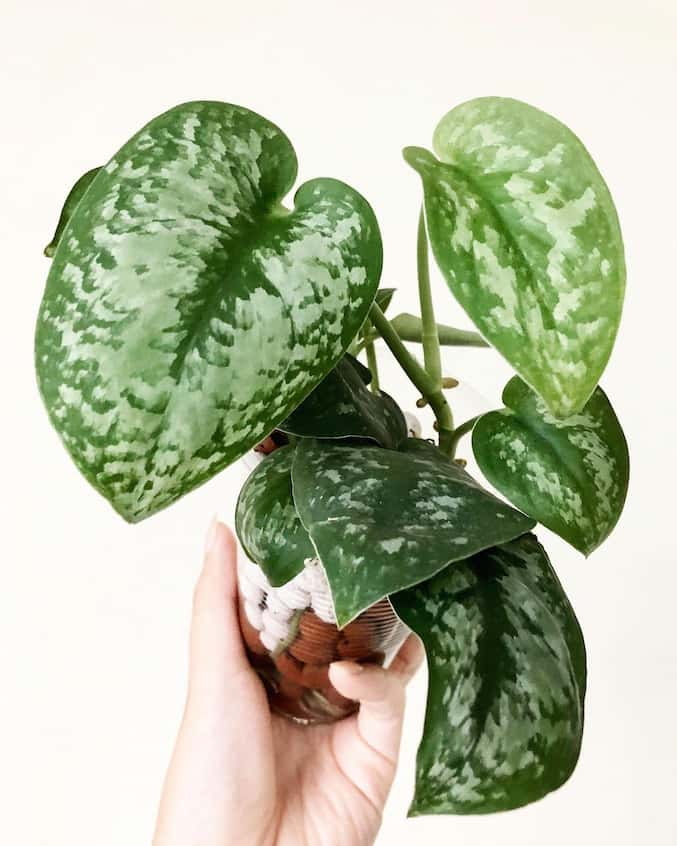
Table of Contents
What is a silver splash pothos?
The Silver Splash pothos (Scindapsus pictus “Silver Splash”) is a variety of houseplant in the Alum family. It has the same iconic heart-shaped leaves that the pothos is well-known for. However, a silver splash pothos is actually not a pothos at all.
What makes things even more confusing is that, not only does this plant share the name pothos with the well-known pothos plant (Epipremnum aureum), but it also has the same growing requirements as most types of pothos.
It even looks extremely similar. This has led people to believe that the Silver Splash is a member of the pothos family when, in fact, it is a completely different plant altogether.
What makes the Silver Splash pothos so special is the iridescent silver color on its foliage. The variegation on this tropical evergreen vine has a splotchy-like appearance, and it can be grown in a hanging basket or trailing on a trellis, wall, or pole.
How do you care for a silver splash pothos?
The Silver Splash pothos isn’t a difficult plant to care for, but it does need a certain care to thrive for years to come. This includes the right temperature, humidity level, sunlight, watering, and feeding.
1. Bright, indirect light
The Silver Splash pothos need bright light that is indirect. Direct light will cause the plant’s leaves to burn, while too little light will cause the plant’s color to fade. This plant will tolerate some medium to lower light conditions, but it can impede its growth rate.
The best location for the Silver Splash pothos is near an east-facing or north-facing window. If the plant is close to the window, you may have to use something like a blind or sheer current to help diffuse the light coming through. Artificial lighting can be used if you are unable to give the Silver Splash pothos the right type of natural light.
2. Regular watering
Silver Splash pothos prefer to allow their soil to dry out a bit before watering. Wait to water the plant until about 75% of its soil is dry. When it is time to water the Silver Splash pothos, make sure to do so deeply, soaking the roots and allowing the excess water to drain out.
You can check the dryness of the soil by inserting your finger about 2nd knuckle deep into the soil. If it feels dry, the plant will need watering. If, however, the soil still feels moist, wait two or so days before once again checking the moisture level of the soil.
Tap water, distilled water, and filtered water can all be used to water the Silver Splash pothos. If, however, you use tap water, it is generally recommended to let the water sit out for about 24 hours before watering your plants with it. This will allow the chlorine, which is added to tap water, enough time to dissipate from the water.
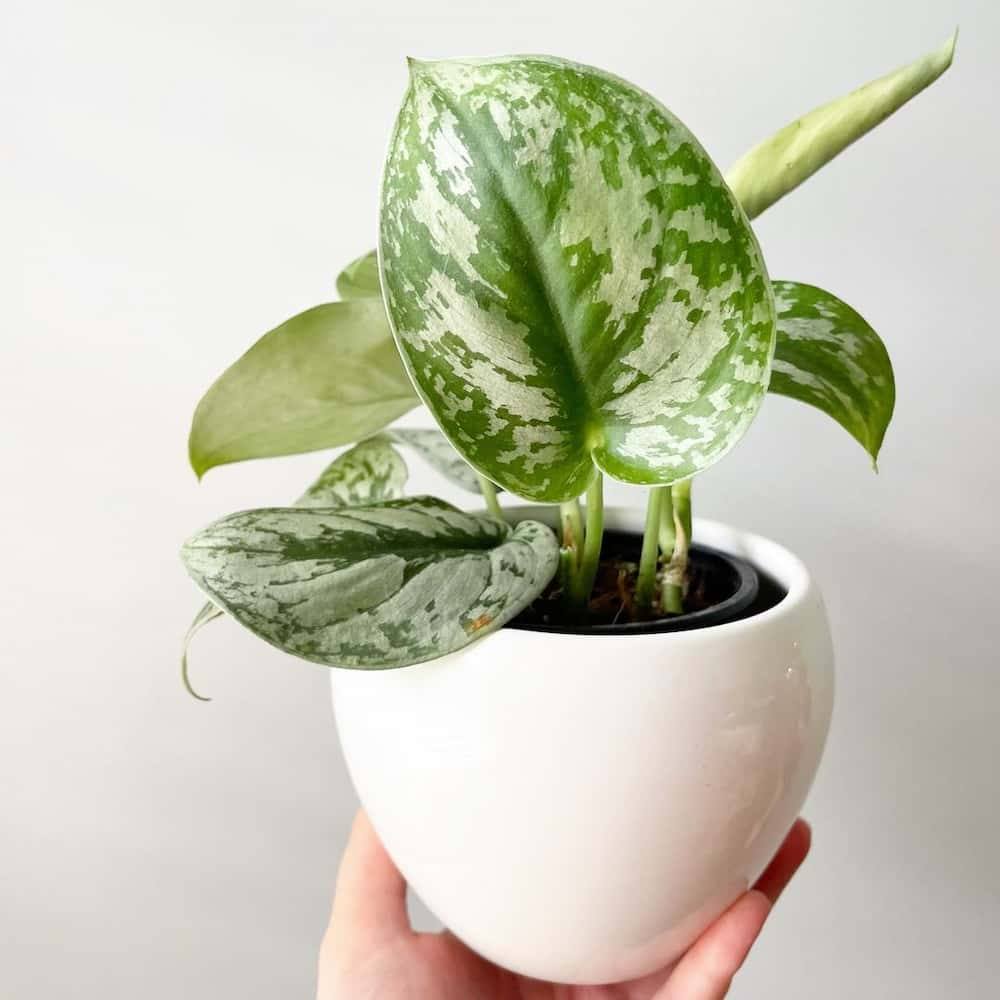
3. Consistent temperature levels
The Silver Splash pothos variety does the best in temperatures of between 65 and 85 degrees Fahrenheit. Keep the plant away from areas where extreme temperature fluctuations, such as open vents, drafty windows, or exterior doors.
If you live in an area where the temperatures fall between 65 and 85 degrees during certain times of the year, you can set the Silver Splash pothos outside to get some fresh air.
Just make sure it is still kept out of direct sunlight and that it is protected from the elements, such as heavy wind and rain, and hail. Furthermore, avoid leaving the plant outside when the temperatures begin to drop below 65.
4. Right humidity percentages
The average humidity in homes, which is around 40 to 60 percent, is typically fine for this plant. If the air starts to get drier, however, you may have to mist the Silver Splash pothos occasionally. The goal should be to keep the humidity level around 50 percent or a little lower.
A humidifier or a drip tray can work perfectly to increase the amount of humidity near the Silver Splash pothos. For the drip tray, set the pot on top of a shallow tray filled with pebbles.
Whenever you water the plant, the excess water runs out of the pot and fills the drop tray. This water will then naturally evaporate into the air and increase the humidity level around the Silver Splash Scindapsus.
5. Well-draining soil
Silver Splash pothos need soil that is well drained and light. Mixing equal parts of potting soil, perlite, and peat moss is a good choice for this tropical plant. However, it doesn’t matter how well the soil drains if the container doesn’t drain just as well.
That is why it is vital to ensure the Silver Splash pothos has a container with drainage holes at the bottom. Avoid using pots with holes along the sides or, worse yet, pots without drainage holes. These types of containers only increase the chance of fungal problems.
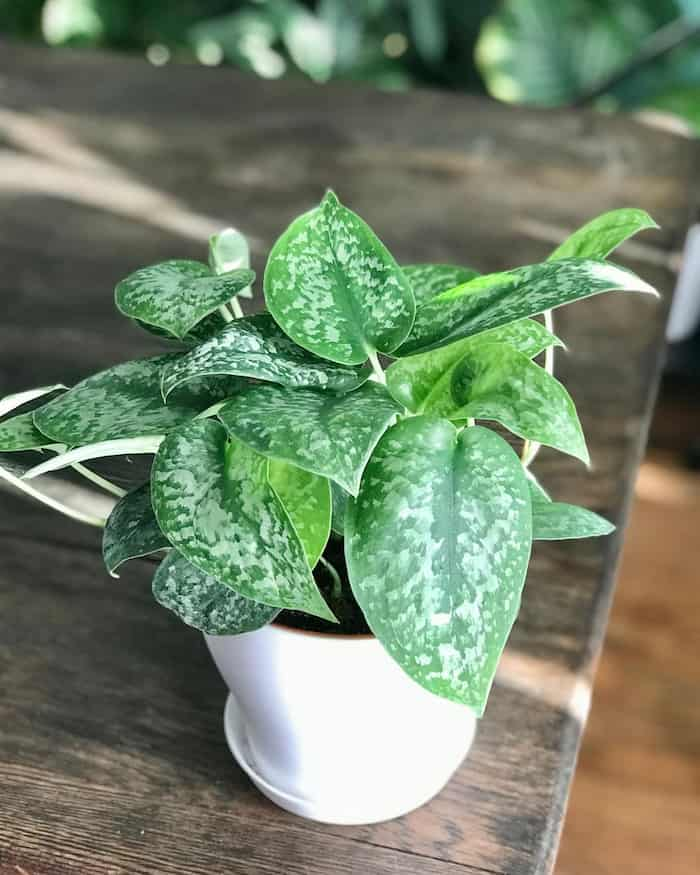
6. Keep an eye out for disease
Silver Splash pothos are not susceptible to too many diseases, but the one that can cause problems is root rot. This fungal disease is caused by overwatering and, despite its seriousness, is easy to prevent. Once the root rot has taken hold, however, it can be difficult to save the plant.
Don’t fret if you merely overwatered the plant once as this is unlikely to cause root rot. Simply stop watering the plant until the soil starts to dry out. The real problem comes when you have overwatered the plant many times.
If you have overwatered the Silver Splash pothos multiple times, you will need to carefully slide the plant from its pot and remove all the soil. Examine the roots and carefully snip any that are dead and diseased. The plant will then need to be repotted in a clean, sterilized pot, and fresh soil.
7. Check for pests
The most common pests that attack the pothos are scales and mealybugs. These sap-sucking insects pierce the skin of the plant and suck out the vital cells that the plant needs. The good news is that sap-sucking insects are usually more of an annoying problem than a serious one.
You can easily get rid of these pests by spraying the Silver Splash pothos with horticultural oil. Horticultural oil is a relatively safe pesticide that can be used indoors around people and pets. It works well to suffocate sap-sucking insects without harming beneficial insects, which means it can also be used outdoors.
Keep in mind, however, that even though they are generally easy to get rid of, they can spread quickly to other plants growing in your home. So if you notice these pests on one of your plants, you may have them on others. To be safe, consider treating all of your houseplants with horticultural oil.
8. Fertilize occasionally
From the spring through the fall, feed the Silver Splash pothos a liquid all-balanced fertilizer once a month at half strength. Avoid applying too much fertilizer as this will cause problems with the plant, and never feed the pothos during the winter when it is dormant.
To help avoid over fertilizing the plant, read and follow the usage instructions located on the fertilizer’s bottle, and never apply more fertilizer than what is listed on the label. If you start to notice the plants’ leaves turning yellow, immediately stop feeding. This is a common sign that the plant has been overfed.
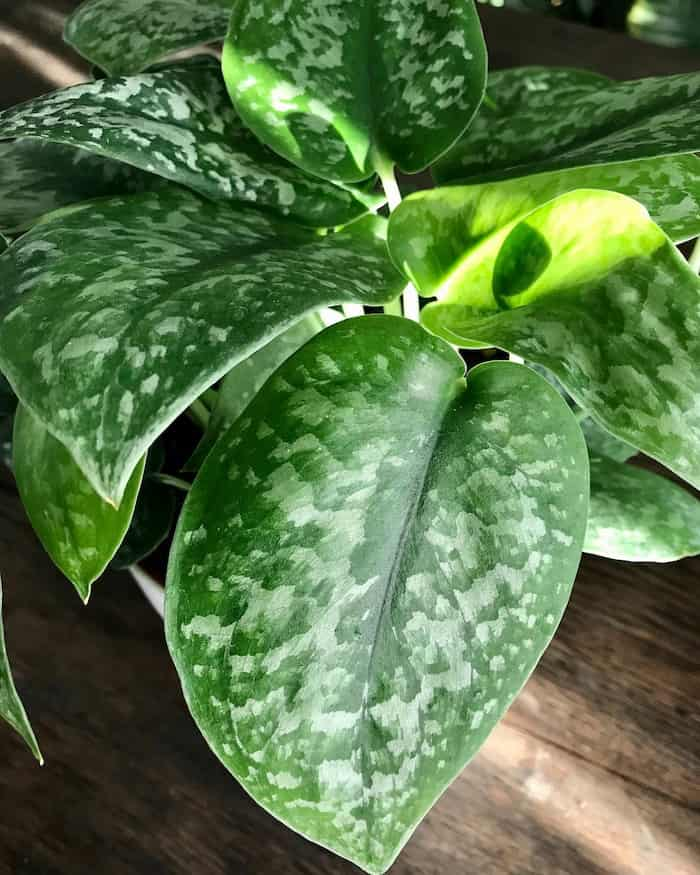
9. Pruning regularly
The Silver Splash Scindapsus doesn’t require pruning, though it can benefit the plant. This is especially true if you want to limit how big the plant gets. Pruning can help you reduce the size of the plant, and even give you the ability to shape the way it looks.
Like other vining plants, the Silver Splash pothos can become long or leggy, which simply means it has more stem and less leaves. Pruning the plant helps to control the legginess of the plant and even encourages growth, which will give the Silver Splash pothos a more bush-like appearance.
When pruning, make sure to only use a clean pair of pruning shears that are sharp and can cleanly cut through the plant’s stem. Before making even the first cut, decide where you will be pruning the plant at, and then cut just above a leaf node.
10. Propagating when you wish
If you want to propagate one of your pothos, the Silver Splash pothos is the one to do it on. This plant is extremely easy to propagate and root, and it only takes a few minutes to increase the amount of pothos you are growing. To start, simply locate a stem that has several leaves and cut 4 to 5 inches off.
Remove and discard the leaves at the lower portion of the stem, but make sure to keep a few leaves on as this is where the plant will absorb the sunlight. Dip the cut end of the stem into the rooting hormone and then place the cut end into a glass filled with water. Set the glass in an area where it will get bright, indirect sunlight and then change the water once a week.
After about 2 to 3 weeks, you will start to see roots forming on the cutting. When these roots are about 2 inches long, plant the cutting in a pot filled with the same type of soil the parent plant is growing in. Then simply care for the young plant as you normally would.
You may also be interested in: 8 Simple Steps to Propagate Pothos Without Leaves
11. Repotting as needed
Unless there is an emergency situation that requires repotting, you probably will only have to repot the Silver Splash pothos once every 3 or so years when it outgrows its pot. You will know when its time to repot because the roots of the plants will start to stick out of the top of the soil or come out the bottom of the pot.
When it is time to repot, select a pot that is at least 2 times the size of the current pot, but no more than 3 times its size. This ensures the plant has enough room to grow without providing it with too much room. If possible, wait until the spring or summer months to repot the pothos plant.
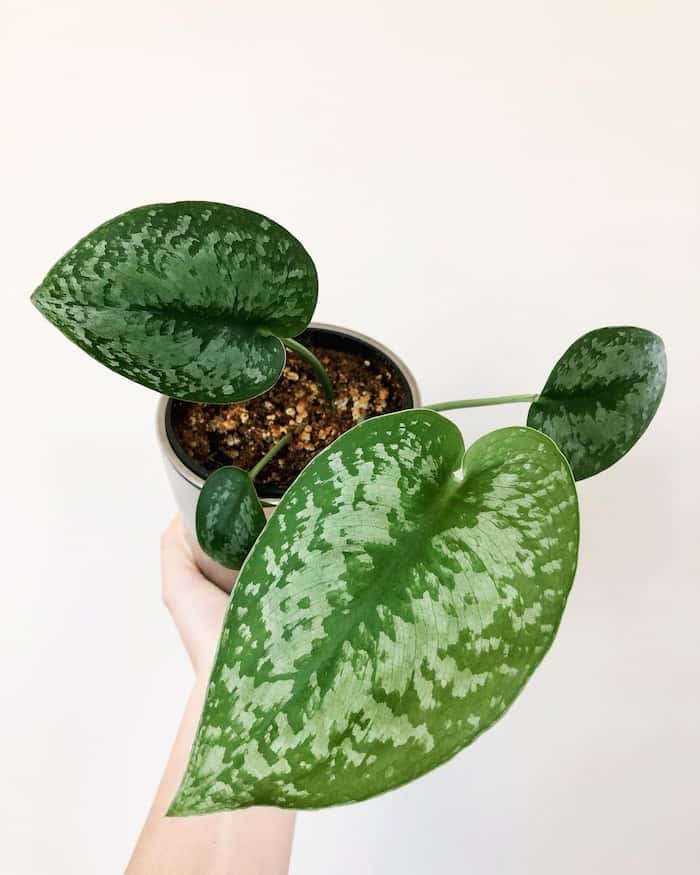
12. Be aware of its toxicity
The Silver Splash pothos is toxic to humans, cats, and dogs. The plant contains calcium oxalates, which can cause irritation and burning to the lips, mouth, tongue, and throat of anything that ingests it. While it is not usually fatal unless consumed in larger amounts, it can cause excessive drooling, difficulty breathing, and gastrointestinal issues, such as vomiting and diarrhea.
Symptoms typically pass in 24 to 48 hours, although you should seek medical treatment if the symptoms are severe, they have difficulty breathing, or if an excessive amount of the plant was consumed. For children and pets, it’s better to be safe than sorry and reach out to a medical professional or poison control to get their opinion as to whether or not a trip to the emergency room is needed.
Because of its toxicity, you should never allow children or pets to bother the Silver Splash pothos. Another option is to avoid the pothos plants altogether and grow a pet and child-safe plant instead, such as a Boston fern.
What is the difference between silver splash pothos vs exotica?
The main difference between the Silver Splash pothos and the Scindapsus pictus Exotica is the pattern and color of the variegation. Both plants have thick, large leaves, but the silver splash has a dappled-like variegation, while the Exotica has a more streaked pattern.
As for the coloring, the Silver Splash is more silvery-blue, similar to an iridescent-like color, while the Extoica has a more silver variegation.
Silver Splash Scindapsus and Scindapsus pictus Exotica have the same growing requirements, which means plenty of bright, indirect light, warm temperatures, and well-draining soil. They are also both hard to come by and can leave you scratching your head as to where you can obtain these stunning tropical vines.
What’s the difference between silver splash pothos vs satin pothos?
A Satin pothos is simply another name for the Exotica pothos. So the differences between the two are the same: different variegation of color and pattern. Along with the name Satin pothos, Exotica pothos is also known as Silver pothos.
Even though they look a bit different, the Silver Splash and Satin pothos require the same care and growing conditions. This makes it easy if you want to grow many different varieties of the Scindapsus pictus, since you won’t have to give each plant a different level of care.
Find out more: Silver Satin Pothos: The Ultimate Guide
What’s the difference between silver splash pothos vs silvery Ann?
The Silvery Ann pothos has silvery green variegation with softer leaves than the Silver Splash. Another difference between the two is that the Silvery Ann pothos has a much stronger variegation, and on some of its leaves it can look as though part of it has been dipped directly in silver paint.
Besides the difference in appearance, both the Silver Splash pothos and the Silvery Ann pothos do need the same growing requirements. Because they have these growing conditions in common, it’s easy to add another Scindapsus plant to your indoor garden.
What’s the difference between scindapsus silver splash vs silver lady?
The Silver Lady pothos has smaller leaves than the Silver Splash pothos, and the variegation is quite different as well. While the Silver Splash foliage is more green with silvery splotches, the Silver Lady foliage is more silver with specks of green.
The Silver Lady’s leaves are also thinly lined with silver, which is something that the Silver Splash pothos does not have.
Despite these differences, the Scindapsus Silver Splash and Silver Lady have the same requirements when it comes to their care. They both need warm temperatures, bright and indirect light, well-drained soil, and humidity levels of 50-percent or above. They are also both considered rather rare and can be difficult to locate.
Is silver splash pothos rare?
Silver Splash scindapsus is considered rare, but not impossible to get. It is often confused with the less rare scindapsus pictus Exotica because the two are so similar in appearance. Because it can be confused with a different cultivar, it is important to find a trusted source to obtain the Silver Splash pothos from.
Keep in mind that when a plant is rare, it is harder to find and thus, it will generally have a higher price tag. So be prepared to pay more for this plant than you would for a pothos you can easily find in the store. Additionally, if you are able to locate a Silver Splash pothos, you may want to consider propagating the plant and sharing it with friends and family members.
Sharing the cuttings of a rare plant is a great way to “spread the love” and allow others to experience the joy of growing a plant that they may not have been able to get their hands on otherwise. It can also mean they share with you some of their cuttings in the future.
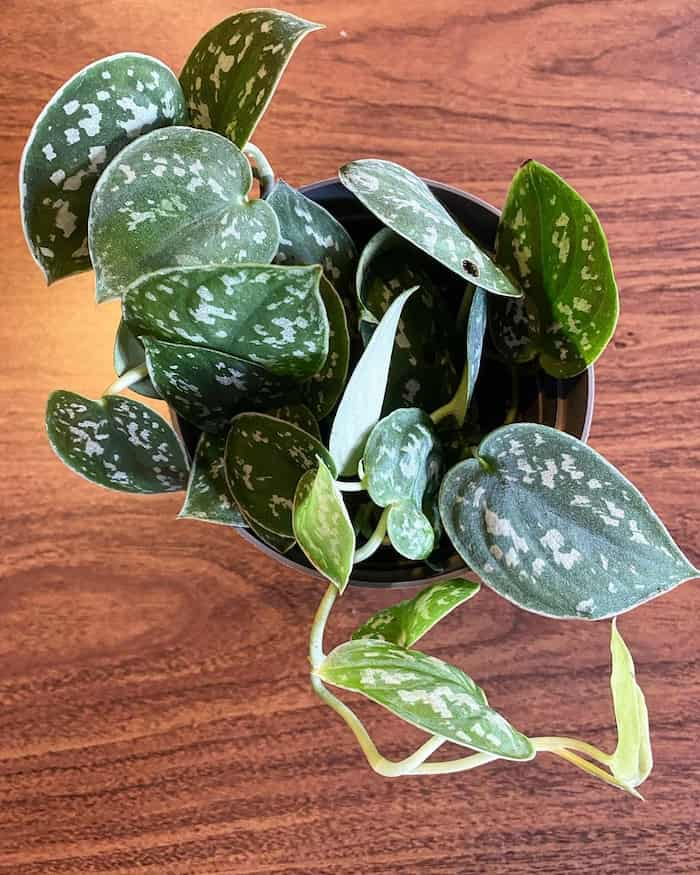
Where to find a silver splash scindapsus for sale
Even though the Silver Splash scindapsus is considered a rare houseplant, you can still find it at various locations. In most cases, however, you will have to scour the internet looking for this plant, but before you do that, consider checking with your local nurseries and garden centers.
When looking online for Silver Splash scindapsus, take care to read the reviews for the shop or person that is selling the plant. There have been some reports of sellers claiming the plant is a Silver Splash when it is, in fact, a Scindapsus pictus Exotcia.
No matter where you get your plant, if it has to be ordered, you may have to pay for shipping. This extra charge can quickly double or even triple the overall price of the plant, which can easily put the cost out of your budget. Just keep this in mind when shopping for the Silver Splash pothos.
